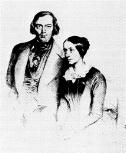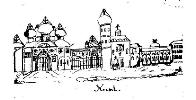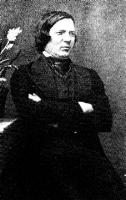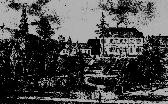The
biography of Schumann 1841-1856
Schumann composed no fewer than 138 songs
during his “Liederjahr” of 1840, among them the Liederkreis, op. 39, Frauenliebe-
und Leben, op. 42, and Dichterliebe, op. 48. “And I have so much music
in me that I want to sing the entire day through. Especially when I am
composing songs in the morning hours from six o’clock on…” The first years
together with Clara lent his inspiration wings. After the song phase came
his First Symphony (the “Spring Symphony”). As the Papillons were the spring
creations of his piano works, so the “Spring Symphony” was the product
of his life with Clara, and was written in the spirit of Beethoven, Schubert
(the Symphony in C major), and Mendelssohn. Clara wrote: “I am very happy.
Robert finished his symphony on Tuesday, composed from beginning to end
in just four days…I must confess, dear husband, that I had not thought
you capable of such dexterity. You fill me with an ever-increasing awe!!!”
Mendelssohn conducted the premiere at the Leipzig Gewandhaus, one of the
greatest successes in Schumann’s life.

A number of pieces followed: the Overture,
Scherzo and Finale for orchestra , op. 52, the first movement of the Piano
Concerto, op. 54, and the first version of the Symphony in D minor (later
designated the Fourth, op. 120). Schumann’s first child, Marie, was born
in September 1841. Afterwards Clara resumed her concert career, and for
the first time the problems of a marriage between two practicing artists
were apparent. Only when Clara had returned from touring did her husband’s
creativity return. 1842 was the “Chamber Music Year,” which saw the composition
of Three String Quartets, op. 41, the Piano Quartet, op. 47, and the Piano
Quintet, op. 44. The year afterwards Schumann composed the secular oratorio
Das Paradis und die Peri, and conducted the triumphantly successful premiere
himself. As teacher at the new Conservatory in Leipzig he had less success.
His increasingly advanced introversion was a source of confusion to his
students.
 The couple’s trip to Russia triggered a serious crisis. Clara’s playing
was very successful, but Robert suffered in his secondary role as the husband
of a celebrated pianist. However, Russian musicians were moved by the novelty
of his music, which made a great influence on the younger Russian composers.
After the tour was over, Schumann found himself unable to compose. He gave
up the editorship of the magazine. The constant hearing problems plagued
him to the point of sleeplessness and he feared for his life. With great
difficulty he composed sections from Goethe’s Faust, originally intended
as an opera.
The couple’s trip to Russia triggered a serious crisis. Clara’s playing
was very successful, but Robert suffered in his secondary role as the husband
of a celebrated pianist. However, Russian musicians were moved by the novelty
of his music, which made a great influence on the younger Russian composers.
After the tour was over, Schumann found himself unable to compose. He gave
up the editorship of the magazine. The constant hearing problems plagued
him to the point of sleeplessness and he feared for his life. With great
difficulty he composed sections from Goethe’s Faust, originally intended
as an opera.
On a physician’s advice the family moved
to Dresden. Systematic study of Bach scores slowly helped Schumann’s condition.
Six Fugues on BACH for organ or “Pedalflügel,” op. 60, are the result,
as well as Skizzen and Studien für Pedalflügel, op. 56, and op.
58 (a pedal piano consists of a grand piano fitted with a full pedal keyboard
similar to that of an organ, which the Schumanns had rented in order to
play Bach’s organ works on the piano). For piano the composer wrote the
Fugues, op. 72. In addition, during this difficult period he finished one
of his most beautiful works, the Piano Concerto in A minor, op. 54.
He sketched out the Second Symphony in
C major the same year, at the completion of which he felt healthy again.
“Yes — I think it is a real ‘Jupiter,’” Schumann is said to have commented
about the piece, one that made Clara especially enthusiastic. In this period
he had multiple dealings with Richard Wagner. “It contains much that is
quite moving” began Schumann’s reserved critique of the latter’s Tannhäuser:
Wagner “could be of great importance for the stage, and if I have judged
him correctly, he has the necessary courage.” “Separate from the drama,”
however, Schumann harbored grave doubts about Wagner‘s music.
The Schumann family now tallied four children.
Following the modest success of the Second Symphony and an unsuccessful
concert tour to Vienna with Clara (featuring the Piano Concerto and the
First Symphony) the composer turned to composing Piano Trios. He also occupied himself with “Scenes from Goethe’s
Faust” and began working on his sole opera, “Genoveva” (after Tieck and
Hebbel). 1847 brought the unexpected death of Felix Mendelssohn, an event
that affected Schumann deeply. The year of European revolution proved one
of his most productive. He completed “Genoveva.” A day later he began the
composition of Byron’s “Manfred,” and finished the third part of “Scenes
from Goethe’s Faust.” The theme of redemption was the focal point of much
of the material that occupied Schumann at the time.
to composing Piano Trios. He also occupied himself with “Scenes from Goethe’s
Faust” and began working on his sole opera, “Genoveva” (after Tieck and
Hebbel). 1847 brought the unexpected death of Felix Mendelssohn, an event
that affected Schumann deeply. The year of European revolution proved one
of his most productive. He completed “Genoveva.” A day later he began the
composition of Byron’s “Manfred,” and finished the third part of “Scenes
from Goethe’s Faust.” The theme of redemption was the focal point of much
of the material that occupied Schumann at the time.
The Schumann family felt increasingly isolated
in Dresden. The centennial of Goethe’s birth saw no performances of the
composer’s Requiem für Mignon (Goethe), the third part of his Faust
setting, or his opera Genoveva. Schumann accepted an offer from Ferdinand
Hiller to succeed him as music director in Düsseldorf. After his Genoveva
finally received its premiere, with only tepid success, Schumann and family
moved to Düsseldorf.
His conducting was problematical: his taciturnity,
his extreme shortsightedness (not correctable at the time), his quiet manner
of speaking, and his plain lack of leadership ability led to a failure
of discipline in the orchestra. All of Schumann’s energies were invested
in his true calling. He wrote his Third Symphony, which was subtitled the
“Rhenish” by Schumann’s first biographer, the Düsseldorf concertmaster
Wasielewski. The Cello Concerto, op. 129, appeared and Schumann worked
further on his Faust scenes. In 1851 he composed Sonatas for Violin, the
musical fairy tale Der Rose Pilgerfahrt for soloists, chorus and orchestra,
and the Fantasiestücke, op. 111.

Toward the end of his life Schumann produced
musical settings of biblical texts. He composed the Mass, op. 147, and
the Requiem, op. 148. In 1853 he composed the Fantasy for violin and orchestra,
op. 131, and the Concerto Allegro in D minor for piano and orchestra, op.
134, a work that exercised a great influence on the Piano Concerto in D
minor of Brahms. He also finished the “Scenes from Goethe’s Faust.” The
Schumann family children had since grown in number to six. The composer
dedicated one of the Piano Sonatas for the Young, op. 118, to each of his
three eldest daughters Julie, Elise, and Marie. The Fughettas, op. 126,
and the “Songs for an Early Hour,” op. 133, were the last works published
during Schumann’s lifetime. His last triumph as conductor and composer
was the performance of the revised version of his Symphony in D minor on
a program that included Beethoven’s Violin Concerto played by Joseph Joachim.
On July 30, 1853 Schumann suffered a nervous breakdown. Through Joachim
he was introduced to Johannes Brahms, and in a last, enthusiastic article
for the Neue Zeitschrift für Musik he used the term “anointed” to
describe the younger man. In November Schumann was informed by the Düsseldorf
Musikverein that henceforth he would only be allowed to conduct his own
works—a politely-phrased dismissal.
By the year 1853 Robert and Clara had been
married for thirteen years and lived in Düsseldorf. Clara went on
a successful concert tour of the Netherlands, accompanied by her husband.
This trip was also a great success for Schumann as a composer. Health problems,
however, were causing him ever greater difficulties. Auditory hallucinations
tormented his spirit, and he had a fear of going insane. Clara despaired
— probably overwhelmed by the situation, she saw a sanitarium stay as the
only solution. Robert, however, had a lifelong fear of such institutions,
which at the time were little better than torture chambers. Now his beloved
Clara wanted him committed to one, and he felt left with only one solution
— suicide. The Monday before Lent, 1854 is portrayed in the memoirs of
daughter Marie, then twelve years old: “I was supposed to remain in Mother’s
sitting room and see if Father, who was in his room next door, needed anything.
I sat there for awhile at Mother’s small desk when the door of the room
opened and my Father stood there in his long, green-flowered dressing gown.
His face was totally white. When he saw he covered his face in his hands
and cried, ‘Oh God.’ Then he disappeared again.”
 Schumann
walked to a nearby bridge, threw his wedding ring into the water, and leaped
into the Rhine. He was rescued, declared mentally incapacitated, and a
physician and two orderlies escorted him to the sanitarium in Endernich.
After a raving fit he was put into a strait jacket. In this supposedly
modern institution he was inflicted with the “Siegburger Delle,” in which
an infection was artificially caused by the administration of mercury through
a hole in his skull. Modern scholarship has linked the progressive paralysis
of Schumann’s sickness to a syphilitic infection contracted in 1831, for
which accurate diagnosis and effective treatment would not be a reality
until the early 20th century.
Schumann
walked to a nearby bridge, threw his wedding ring into the water, and leaped
into the Rhine. He was rescued, declared mentally incapacitated, and a
physician and two orderlies escorted him to the sanitarium in Endernich.
After a raving fit he was put into a strait jacket. In this supposedly
modern institution he was inflicted with the “Siegburger Delle,” in which
an infection was artificially caused by the administration of mercury through
a hole in his skull. Modern scholarship has linked the progressive paralysis
of Schumann’s sickness to a syphilitic infection contracted in 1831, for
which accurate diagnosis and effective treatment would not be a reality
until the early 20th century.
Clara would not visit the sanitarium for
two and a half years. Johannes Brahms assisted the family after the catastrophe,
living with them for a year and a half. Clara first visited her husband
a few days before his death in 1856.
 An
account in a letter from Bettina von Arnim, to whom the Gesänge der
Frühe are dedicated, who portrayed him as almost healed after a visit
to Endenich in 1855, rings true. Likewise Schumann’s own letters to his
publisher and his encouraging letters to Brahms, who also made multiple
visits. Liszt dedicated his greatest piano work, the Sonata in B Minor,
to Schumann.
An
account in a letter from Bettina von Arnim, to whom the Gesänge der
Frühe are dedicated, who portrayed him as almost healed after a visit
to Endenich in 1855, rings true. Likewise Schumann’s own letters to his
publisher and his encouraging letters to Brahms, who also made multiple
visits. Liszt dedicated his greatest piano work, the Sonata in B Minor,
to Schumann.  Towards
the end of 1855 Schumann was failing, though the handwriting of his last
letter to Clara is unusually clear. He died on July 29, 1856. Johannes
Brahms would later write: “The memory of Schumann is sacred to me. The
noble, dedicated artist remains my ideal, and I doubt I will ever love
a human being more — hopefully I will never again be forced to watch and
experience such a terrible fate at such close quarters.”
Towards
the end of 1855 Schumann was failing, though the handwriting of his last
letter to Clara is unusually clear. He died on July 29, 1856. Johannes
Brahms would later write: “The memory of Schumann is sacred to me. The
noble, dedicated artist remains my ideal, and I doubt I will ever love
a human being more — hopefully I will never again be forced to watch and
experience such a terrible fate at such close quarters.”
mbasting@t-online.de
Translation: William Melton
© Franz Vorraber

 The couple’s trip to Russia triggered a serious crisis. Clara’s playing
was very successful, but Robert suffered in his secondary role as the husband
of a celebrated pianist. However, Russian musicians were moved by the novelty
of his music, which made a great influence on the younger Russian composers.
After the tour was over, Schumann found himself unable to compose. He gave
up the editorship of the magazine. The constant hearing problems plagued
him to the point of sleeplessness and he feared for his life. With great
difficulty he composed sections from Goethe’s Faust, originally intended
as an opera.
The couple’s trip to Russia triggered a serious crisis. Clara’s playing
was very successful, but Robert suffered in his secondary role as the husband
of a celebrated pianist. However, Russian musicians were moved by the novelty
of his music, which made a great influence on the younger Russian composers.
After the tour was over, Schumann found himself unable to compose. He gave
up the editorship of the magazine. The constant hearing problems plagued
him to the point of sleeplessness and he feared for his life. With great
difficulty he composed sections from Goethe’s Faust, originally intended
as an opera.
 to composing Piano Trios. He also occupied himself with “Scenes from Goethe’s
Faust” and began working on his sole opera, “Genoveva” (after Tieck and
Hebbel). 1847 brought the unexpected death of Felix Mendelssohn, an event
that affected Schumann deeply. The year of European revolution proved one
of his most productive. He completed “Genoveva.” A day later he began the
composition of Byron’s “Manfred,” and finished the third part of “Scenes
from Goethe’s Faust.” The theme of redemption was the focal point of much
of the material that occupied Schumann at the time.
to composing Piano Trios. He also occupied himself with “Scenes from Goethe’s
Faust” and began working on his sole opera, “Genoveva” (after Tieck and
Hebbel). 1847 brought the unexpected death of Felix Mendelssohn, an event
that affected Schumann deeply. The year of European revolution proved one
of his most productive. He completed “Genoveva.” A day later he began the
composition of Byron’s “Manfred,” and finished the third part of “Scenes
from Goethe’s Faust.” The theme of redemption was the focal point of much
of the material that occupied Schumann at the time.

 Schumann
walked to a nearby bridge, threw his wedding ring into the water, and leaped
into the Rhine. He was rescued, declared mentally incapacitated, and a
physician and two orderlies escorted him to the sanitarium in Endernich.
After a raving fit he was put into a strait jacket. In this supposedly
modern institution he was inflicted with the “Siegburger Delle,” in which
an infection was artificially caused by the administration of mercury through
a hole in his skull. Modern scholarship has linked the progressive paralysis
of Schumann’s sickness to a syphilitic infection contracted in 1831, for
which accurate diagnosis and effective treatment would not be a reality
until the early 20th century.
Schumann
walked to a nearby bridge, threw his wedding ring into the water, and leaped
into the Rhine. He was rescued, declared mentally incapacitated, and a
physician and two orderlies escorted him to the sanitarium in Endernich.
After a raving fit he was put into a strait jacket. In this supposedly
modern institution he was inflicted with the “Siegburger Delle,” in which
an infection was artificially caused by the administration of mercury through
a hole in his skull. Modern scholarship has linked the progressive paralysis
of Schumann’s sickness to a syphilitic infection contracted in 1831, for
which accurate diagnosis and effective treatment would not be a reality
until the early 20th century.
 An
account in a letter from Bettina von Arnim, to whom the Gesänge der
Frühe are dedicated, who portrayed him as almost healed after a visit
to Endenich in 1855, rings true. Likewise Schumann’s own letters to his
publisher and his encouraging letters to Brahms, who also made multiple
visits. Liszt dedicated his greatest piano work, the Sonata in B Minor,
to Schumann.
An
account in a letter from Bettina von Arnim, to whom the Gesänge der
Frühe are dedicated, who portrayed him as almost healed after a visit
to Endenich in 1855, rings true. Likewise Schumann’s own letters to his
publisher and his encouraging letters to Brahms, who also made multiple
visits. Liszt dedicated his greatest piano work, the Sonata in B Minor,
to Schumann.  Towards
the end of 1855 Schumann was failing, though the handwriting of his last
letter to Clara is unusually clear. He died on July 29, 1856. Johannes
Brahms would later write: “The memory of Schumann is sacred to me. The
noble, dedicated artist remains my ideal, and I doubt I will ever love
a human being more — hopefully I will never again be forced to watch and
experience such a terrible fate at such close quarters.”
Towards
the end of 1855 Schumann was failing, though the handwriting of his last
letter to Clara is unusually clear. He died on July 29, 1856. Johannes
Brahms would later write: “The memory of Schumann is sacred to me. The
noble, dedicated artist remains my ideal, and I doubt I will ever love
a human being more — hopefully I will never again be forced to watch and
experience such a terrible fate at such close quarters.”